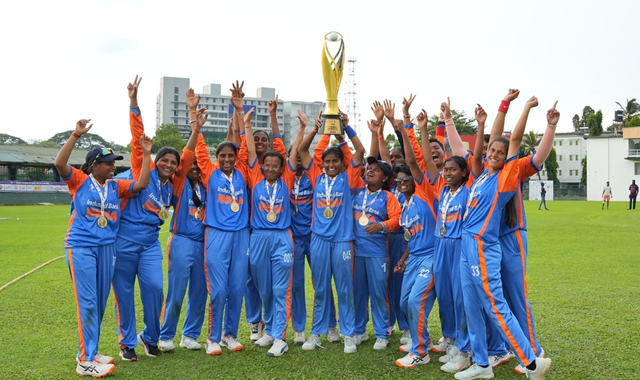How India’s blind women turned sound, instinct, and training innovation into a historic T20 world championship win
When the Indian blind women’s team won the T20 Cricket World Cup, the country cheered, posted, tweeted, and clapped. But what actually helped create this victory was not passion or patriotism, but science, conditioning, and a training ecosystem designed around sound, touch, and memory. This article delves deep into the blind cricket training techniques which moulded these exceptional players into world champions. (Image courtesy: gstatic)
Understanding the Game before Mastering It
Blind cricket is not just an adaptation of the game. It has its own structure-audible cricket balls, tactile stumps, verbal cues, and classification groups including B1, B2, B3. Each training program is designed keeping this fact in mind. (Image courtesy: twimg)
The players practice to listen for the ball, not to see it. They commit distances to memory, rather than identifying them with speed. Their reflexes depend on sensory prioritization.
Coaches ensure they know the rhythms, acoustics, and movement patterns that are unique to blind cricket before they pick up a bat.
This becomes the base layer for all advanced blind cricket training techniques.
Listening Drills: The Heart of Blind Cricket Training
The biggest weapon of the Indian team has always been their hearing accuracy. Batters are trained to recognize: (Image courtesy: bbci)
- The pitch of the ball’s rattle
- The angle from which the bowler announces the delivery.
- The bounce pattern from sound alone
- The distance between bat and ball purely through rhythm.
These drills are often performed in silence with no crowd or any kind of background noise so that the athletes can master micro-cues. Noise is added in later to simulate match settings.
The challenge for bowlers is one of precision. Blind cricket requires predictable underarm or controlled bowling, depending on the category. Consistent, easily audible trajectories must be produced:
Fielders practice “sound triangulation”: finding a moving target using only hearing direction, teammates’ verbal calls, and spatial memory.
This is elite sensory training masquerading as sport.
Spatial Memory & Muscle Memory: The Unsung Tools
Blind women cricketers train their bodies for motion with unwavering confidence since sight is something that cannot guide them. Their training schedules include: (Image courtesy: blindcricket)
- Repeated crease-to-crease running drills
- Guided fielding paths with tactile markers
- Partner-led catching sessions
- Lane-based sprinting exercises
- Footwork patterns repeated hundreds of times
- One repeats every movement, until the body knows the field like a map burned into its muscles.
These are not fitness sessions, but survival mechanisms for a high-pressure sport.
Communication Systems: Turning Voices Into Strategy
Blind cricket is a symphony; every player carries meaning in his voice. (Image courtesy: .bbci)
- Bowlers call out cues before delivery.
- The fielders call out directional indicators.
- Captains give quick, exact orders.
- Runners have to verbally match their tempo with the B1 players.
The Indian women’s team rehearsed these call-and-response systems for months in preparation until they became second nature. Their coordination throughout the World Cup wasn’t an accident; it was engineered.
Strong communication is one of the most defining blind cricket training techniques in the world, and India has mastered it.
Conditioning the Body for a Different Kind of Pressure
The physical training would be similar to that of mainstream cricket, like strength, cardio, speed, and agility, but the intent is different. (Image courtesy: livemint)
Because they rely so much on hearing and instinct, they may be more quickly fatigued and hence lose sensory sharpness than sighted players. Coaches thus build routines that maintain:
- High endurance without sensory burnout
- Stability during diving or sliding
- Explosive movement without any visual cues
- Strong core strength for directional balance
- Huge, also, is mental conditioning: breathing routines, focus-enhancing exercises, and non-visual visualization techniques help the athlete stay centered under pressure.
The Technology and Tools Used in Blind Cricket Training
Special training equipment adapted for the team includes: (Image courtesy: yimg)
- Audible cricket balls with internal rattles
- Tactile or brightly coloured stumps
- Specially designed practice pitches with consistent bounce
- Environmental control – silence for precision, noise for pressure
None of this is ornamental. Each thing is part of a calculated strategy to sharpen sensory response.
Conclusion: When Blind Cricket Training Technique Meets Courage
India’s blind women did not win the T20 World Cup as a miracle. They won because their coaches, federation and athletes committed to rigorous, scientific blind cricket training techniques that maximized every remaining sense. Their victory provided an important reminder that sport can be reimagined to empower, not exclude. And when it is, champions rise.
Of course this win has put India once again in the world map of sports. The team captain Deepika TC appreciated the support she got from Jemimah Rodrigues and Shubman Gill that pushed the team with motivation. Coach Shetty also mentioned how this win will give girls the hope to enter sports and gain support from the family.
To bring such transformational voice to your stage, like Mithila Raj, Sourav Ganguly, Jhulan Nishit Goswami, and many more on women’s cricket team, book through engage4more—India’s top platform for keynote speakers and talent. With over 2,500 artists, pacy bookings, and free event publicity, engage4more makes inspiration accessible, unforgettable, and meaningful. Also, enjoy our value adds like complimentary quizzing for your events along with free publicity by our post-event coverage via our social media handles!

